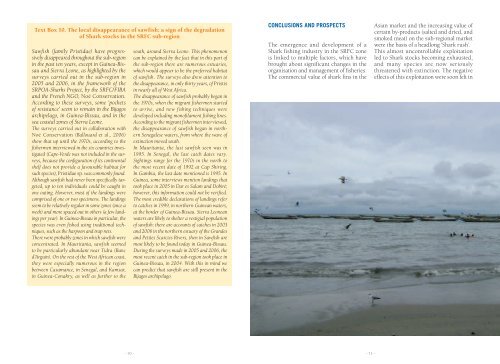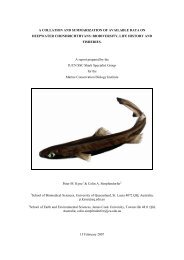30 Years of shark fishing in west africa - Shark Specialist Group
30 Years of shark fishing in west africa - Shark Specialist Group
30 Years of shark fishing in west africa - Shark Specialist Group
Create successful ePaper yourself
Turn your PDF publications into a flip-book with our unique Google optimized e-Paper software.
Text Box 10. The local disappearance <strong>of</strong> sawfish: a sign <strong>of</strong> the degradation<br />
<strong>of</strong> <strong>Shark</strong> stocks <strong>in</strong> the SRFC sub-region<br />
Sawfish (family Pristidae) have progressively<br />
disappeared throughout the sub-region<br />
<strong>in</strong> the past ten years, except <strong>in</strong> Gu<strong>in</strong>ea-Bissau<br />
and Sierra Leone, as highlighted by the<br />
surveys carried out <strong>in</strong> the sub-region <strong>in</strong><br />
2005 and 2006, <strong>in</strong> the framework <strong>of</strong> the<br />
SRPOA-<strong>Shark</strong>s Project, by the SRFC/FIBA<br />
and the French NGO, Noé Conservation.<br />
Accord<strong>in</strong>g to these surveys, some ‘pockets<br />
<strong>of</strong> resistance’ seem to rema<strong>in</strong> <strong>in</strong> the Bijagos<br />
archipelago, <strong>in</strong> Gu<strong>in</strong>ea-Bissau, and <strong>in</strong> the<br />
sea coastal zones <strong>of</strong> Sierra Leone.<br />
The surveys carried out <strong>in</strong> collaboration with<br />
Noé Conservation (Ballouard et al., 2006)<br />
show that up until the 1970s, accord<strong>in</strong>g to the<br />
fishermen <strong>in</strong>terviewed <strong>in</strong> the six countries <strong>in</strong>vestigated<br />
(Cape-Verde was not <strong>in</strong>cluded <strong>in</strong> the surveys,<br />
because the configuration <strong>of</strong> its cont<strong>in</strong>ental<br />
shelf does not provide a favourable habitat for<br />
such species), Pristidae sp. was commonly found.<br />
Although sawfish had never been specifically targeted,<br />
up to ten <strong>in</strong>dividuals could be caught <strong>in</strong><br />
one out<strong>in</strong>g. However, most <strong>of</strong> the land<strong>in</strong>gs were<br />
comprised <strong>of</strong> one or two specimens. The land<strong>in</strong>gs<br />
seem to be relatively regular <strong>in</strong> some zones (once a<br />
week) and more spaced out <strong>in</strong> others (a few land<strong>in</strong>gs<br />
per year). In Gu<strong>in</strong>ea-Bissau <strong>in</strong> particular, the<br />
species was even fished us<strong>in</strong>g traditional techniques,<br />
such as the harpoon and trap nets.<br />
There were probably zones <strong>in</strong> which sawfish were<br />
concentrated. In Mauritania, sawfish seemed<br />
to be particularly abundant near Tidra (Banc<br />
d’Argu<strong>in</strong>). On the rest <strong>of</strong> the West African coast,<br />
they were especially numerous <strong>in</strong> the region<br />
between Casamance, <strong>in</strong> Senegal, and Kamsar,<br />
<strong>in</strong> Gu<strong>in</strong>ea-Conakry, as well as further to the<br />
south, around Sierra Leone. This phenomenon<br />
can be expla<strong>in</strong>ed by the fact that <strong>in</strong> this part <strong>of</strong><br />
the sub-region there are numerous estuaries,<br />
which would appear to be the preferred habitat<br />
<strong>of</strong> sawfish. The surveys also drew attention to<br />
the disappearance, <strong>in</strong> only thirty years, <strong>of</strong> Pristis<br />
<strong>in</strong> nearly all <strong>of</strong> West Africa.<br />
The disappearance <strong>of</strong> sawfish probably began <strong>in</strong><br />
the 1970s, when the migrant fishermen started<br />
to arrive, and new <strong>fish<strong>in</strong>g</strong> techniques were<br />
developed <strong>in</strong>clud<strong>in</strong>g mon<strong>of</strong>ilament <strong>fish<strong>in</strong>g</strong> l<strong>in</strong>es.<br />
Accord<strong>in</strong>g to the migrant fishermen <strong>in</strong>terviewed,<br />
the disappearance <strong>of</strong> sawfish began <strong>in</strong> northern<br />
Senegalese waters, from where the wave <strong>of</strong><br />
ext<strong>in</strong>ction moved south.<br />
In Mauritania, the last sawfish seen was <strong>in</strong><br />
1995. In Senegal, the last catch dates vary.<br />
Sight<strong>in</strong>gs range for the 1970s <strong>in</strong> the north to<br />
the most recent date <strong>of</strong> 1992 at Cap Skir<strong>in</strong>g.<br />
In Gambia, the last date mentioned is 1995. In<br />
Gu<strong>in</strong>ea, some <strong>in</strong>terviews mention land<strong>in</strong>gs that<br />
took place <strong>in</strong> 2005 <strong>in</strong> Dar es Salam and Dobiré;<br />
however, this <strong>in</strong>formation could not be verified.<br />
The most credible declarations <strong>of</strong> land<strong>in</strong>gs refer<br />
to catches <strong>in</strong> 1999, <strong>in</strong> northern Gu<strong>in</strong>ean waters,<br />
at the border <strong>of</strong> Gu<strong>in</strong>ea-Bissau. Sierra Leonean<br />
waters are likely to shelter a vestigial population<br />
<strong>of</strong> sawfish: there are accounts <strong>of</strong> catches <strong>in</strong> 2003<br />
and 2006 <strong>in</strong> the northern estuary <strong>of</strong> the Grandes<br />
and Petites Scarcies Rivers, then <strong>in</strong> Sawfish are<br />
most likely to be found today <strong>in</strong> Gu<strong>in</strong>ea-Bissau.<br />
Dur<strong>in</strong>g the surveys made <strong>in</strong> 2005 and 2006, the<br />
most recent catch <strong>in</strong> the sub-region took place <strong>in</strong><br />
Gu<strong>in</strong>ea-Bissau, <strong>in</strong> 2004. With this <strong>in</strong> m<strong>in</strong>d we<br />
can predict that sawfish are still present <strong>in</strong> the<br />
Bijagos archipelago.<br />
Conclusions and prospects<br />
The emergence and development <strong>of</strong> a<br />
<strong>Shark</strong> <strong>fish<strong>in</strong>g</strong> <strong>in</strong>dustry <strong>in</strong> the SRFC zone<br />
is l<strong>in</strong>ked to multiple factors, which have<br />
brought about significant changes <strong>in</strong> the<br />
organisation and management <strong>of</strong> fisheries.<br />
The commercial value <strong>of</strong> <strong>shark</strong> f<strong>in</strong>s <strong>in</strong> the<br />
Asian market and the <strong>in</strong>creas<strong>in</strong>g value <strong>of</strong><br />
certa<strong>in</strong> by-products (salted and dried, and<br />
smoked meat) on the sub-regional market<br />
were the basis <strong>of</strong> a headlong ‘<strong>Shark</strong> rush’.<br />
This almost uncontrollable exploitation<br />
led to <strong>Shark</strong> stocks becom<strong>in</strong>g exhausted,<br />
and many species are now seriously<br />
threatened with ext<strong>in</strong>ction. The negative<br />
effects <strong>of</strong> this exploitation were soon felt <strong>in</strong><br />
- 70 - - 71 -
















